Radiation characterization and functional verification of COTS components
- Posted by Michael Steffens
- On December 3, 2019
- 0
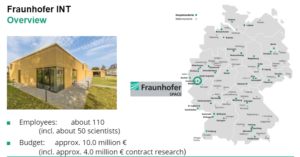
Nuclear Effects in Electronics and Optics (NEO)
Main areas of activity
Investigation and application of the effects of ionizing radiation on optical and electronic components and systems
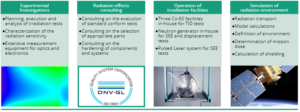
The RACOCO project
-
- Radiation characterization and functional verification of COTS components for
space applications - ESA contract 4000127569/19/NL/FE
- GSTP activity supported by Germany (DLR)
- Awarded to Fraunhofer INT (represented by the Fraunhofer Gesellschaft)
- Technical officer: Gianluca Furano
- Budget 1.2 M€
- Timeline: 2019-2022
- Radiation characterization and functional verification of COTS components for
Aim of RACOCO
- Identify available COTS components
- Functionality or properties should greatly benefit the space community
- Call for participation!
- Will make use of spin-in approach (e.g. AEC-Q)
- Functionality or properties should greatly benefit the space community
- Preliminary assessment and radiation testing of a “long” list of components
- In-depth radiation testing on smaller but comprehensive subset
- Assess test methods and methodology for COTS components in general
- Data and experience on the specific parts/lots can serve as input to guidelines for future COTS testing.
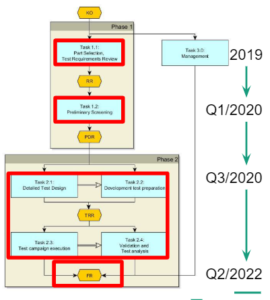 Timeline of RACOCO
Timeline of RACOCO
- The project is currently in the first phase of test candidate identification.
- The basic suitability is then checked in a preliminary screening campaign
- Components that pass this will be subjected to in-depth testing.
- Suitable devices will be recommended for further qualification tests beyond radiation to enable use in space.
Candidate identification
- Build a „long“ list of candidate devices
- Functionality or properties should greatly benefit the space community
- Focus on high integration / high performance / reduced power?
- Call for participation! http://s.fhg.de/racoco-survey
- Why a „long“ list? Examples encountered:
- Target 100 krad(Si) Failing at < 10 krad(Si)
- Target no SEL for LET < 60 MeVcm2/mg failing with low LET to SEL
- Decapsulation issues etc.
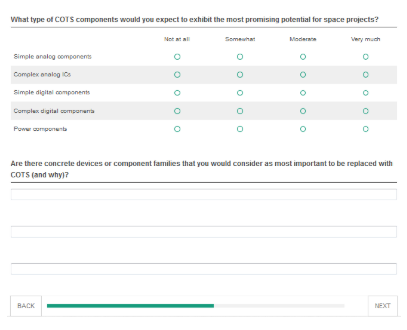
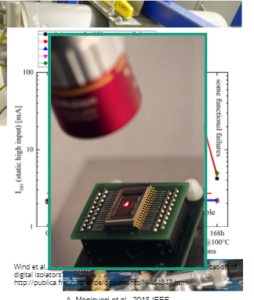 Preliminary screening
Preliminary screening
- The „long“ list of test candidates will be preliminary screened
- focusing on SEL and TID to identify components which allow for a full characterization
- If possible using evaluation boards and reference designs
„short“ list of components with proven feasibility for further testing
Radiation testing campaign
- All parts passing the preliminary screening will be subjected to in-depth testing
- Baseline: SEE, TID according to ECSS 25100 / 22900, DD, ….
- Some components will be subjected to additional tests:
- Board level or assembly tests: How do component effects scale to a board level test?
- Array of SEE test campaigns: Could a proton test be enough?
- What would the reliability be? (e.g. How applicable is the figure of merit?)
- TID: Statistics on large data sets
- Lot to lot, part to part variations, (hopefully pre- and post- a process change)
Output of RACOCO
- Data and experience on an array of COTS components for space
- Eligible COTS Components that have passed all comprehensive radiation and functional tests shall be proposed for further reliability screening and possibly qualification
- Radiation is the focus of this project, but not the only issue with COTS
- Experiences gained during testing shall be submitted to the CTB Radiation working Group in the form of guidelines
- for possible inclusion in European Radiation Hardness Assurance standards
What we also want to learn from RACOCO
- How can we apply „cheap and easy“ preliminary test methods to first assess radiation hardness on unknown components?
- Avoid „trial and error“ full-scale tests up to standards
- How representative and reliable can these preliminary test methods be?
- Can they replace „full scale tests“ for „high-risk“ missions?
- How representative are radiation tests for samples from another lot/date code?
- Links heavily to the use of heritage information and/or COTS databases
Summary
- In RACOCO we will put both COTS components and COTS test strategies to a test (http://s.fhg.de/racoco)
- The project is currently in its initial phase of device selection
- Call for participation! http://s.fhg.de/racoco-survey
-
- Test preparations and preliminary screening in 2020
- „Short“ list of components assembled in Q3/2020
- In-depth testing from Q4/2020 to Q1/2022
- Final report and Guidelines Q2/2022
Latest posts by Michael Steffens (see all)
- Radiation characterization and functional verification of COTS components - December 3, 2019


0 comments on Radiation characterization and functional verification of COTS components